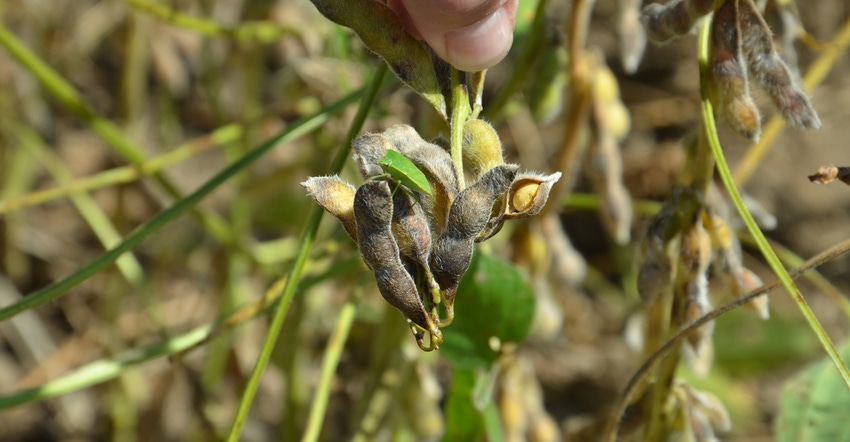
Green stinkbugs, both nymphs and adults, were active in many soybean fields before harvest, particularly in southern Indiana. However, stinkbugs also appeared elsewhere. A few brown stinkbugs were noted, too. Along with insects, growers found pods with shriveled beans, purple or discolored beans, and some pods that were cracking open.
“Many people wanted to lay the blame squarely on stinkbugs, but we don’t believe they deserve all the blame,” says John Obermeyer, Purdue University Extension entomologist. He and Christian Krupke have evaluated plant, pod and grain samples sent to the Purdue Plant and Pest Diagnostic Lab and inspected soybean fields.
“There was a lot going on besides just stinkbugs poking and sucking beans dry inside pods,” Obermeyer says. “We believe in integrated pest management, which means you only spray if an insect meets an economic threshold warranting treatment. Thinking that if you had sprayed for stinkbugs you would have eliminated all of your seed quality issues could be a mistake.”
Darcy Telenko, Purdue Extension plant pathologist, agrees. She notes that insect damage to pods can certainly open the door to various diseases. It’s likely that occurred in some cases, she says.
“However, you can also get the same diseases inside pods without insects ever opening the door,” she adds.
Closer look at insects
There are three stinkbug types that can impact crops: green, brown and brown marmorated, Obermeyer says. The green stinkbug was by far the most common in soybeans this fall.
Stinkbugs can stick their needlelike proboscis through pods into a seed and penetrate it. After the stinkbug sucks moisture out, the seed can shrivel up.
Bean leaf beetles also feed on pods, Obermeyer notes. However, they tend to leave scars and don’t directly feed on seed. There’s often at least a membrane left over the seed.
“Based on what we’ve seen so far, there definitely isn’t a perfect correlation between stinkbugs and shriveled, damaged and discolored seed,” Obermeyer says. “There are other things going on. Also, just because stinkbug numbers were high this year doesn’t mean they will be high next year.”
Disease angle
One of the other things going on were diseases that set up shop inside some soybean pods this fall, Telenko says. Some samples sent to the diagnostic lab at Purdue contained multiple diseases at work within the same field sample. As noted earlier, sometimes insect activity opened the door for disease, but sometimes diseases were present inside the pod without signs of insect activity.
Telenko points to several diseases that showed up more than others in pod samples and on beans this fall. They include cercospora purple seed stain, frogeye leaf spot, phomopsis seed decay, anthracnose, downy mildew and sclerotinia stem rot.
In addition, viruses may infect seed, including bean pod mottle and soybean mosaic. Secondary fungal invaders of injured pods including alternaria, fusarium, penicillium and cladosporium have also been identified.
“It’s a complex issue, and you will need a management plan to reduce potential for disease issues going forward,” Telenko says.
About the Author(s)
You May Also Like




